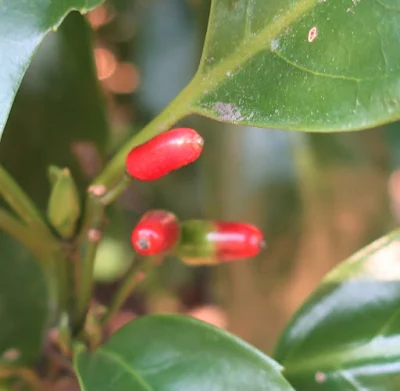These are the berries of aucuba japonica or more commonly known as Japanese laurel at the Hama Rikyu Garden in Tokyo. Round red fruits are often seen but oval ones are unusual.
I didn't! In Japan, people use "blue" for "green." For example, they say "blue" traffic lights and "blue" apples, instead of "green" lights and "green" apples. This is because Japan used to have only four colors, white, black, red and blue, and the then "blue" included green. In "The Man'yoshu," the oldest existing collection of waka or Japanese poetry, compiled sometime after AD 759 during the Nara period (710-784), green leaves were described as "blue" leaves. The color green was differentiated from blue in the 10th century.
The Hama Rikyu Garden, about 62 acres, was built by Tsunashige Tokugawa in 1654 on reclaimed land from Tokyo Bay. The garden was transferred to the Imperial Household Agency in 1870, then to Tokyo in 1945 and opened as a public garden in the following year. You can always enjoy some flowers/plants from cherry blossoms to autumn foliage in the garden.
The Hama Rikyu Garden, about 62 acres, was built by Tsunashige Tokugawa in 1654 on reclaimed land from Tokyo Bay. The garden was transferred to the Imperial Household Agency in 1870, then to Tokyo in 1945 and opened as a public garden in the following year. You can always enjoy some flowers/plants from cherry blossoms to autumn foliage in the garden.




0 件のコメント:
コメントを投稿